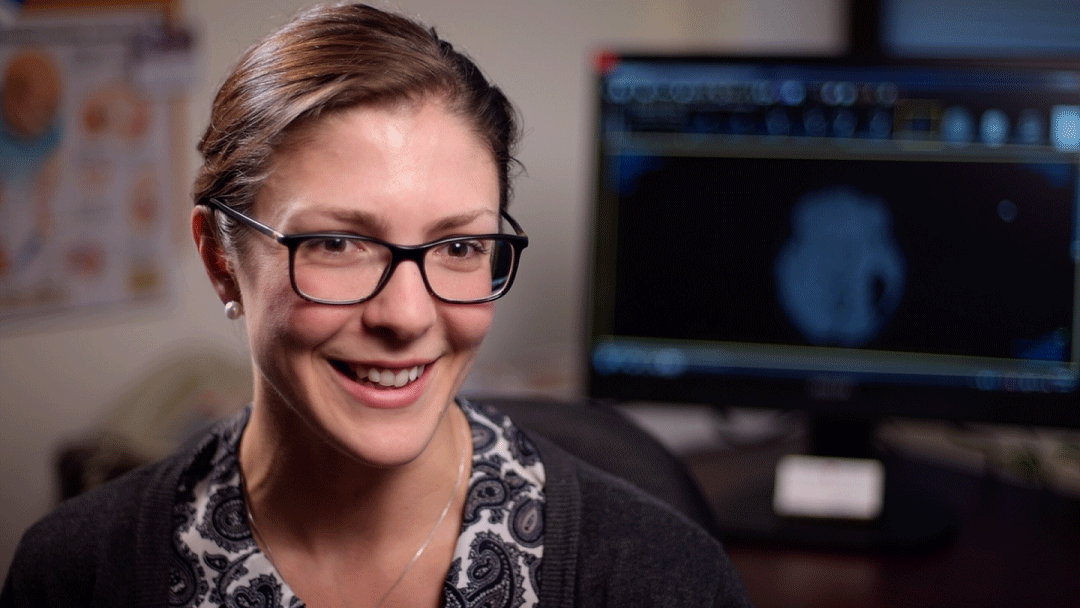
The newest video in the NeuroXXceptional series, celebrating exceptional women at The Neuro, features Kalyna Franko, a speech-language pathologist. In this interview, Franko discusses the role of a speech-language pathologist, her life-long fascination with language, and the inspiration she derives from patients and colleagues.
What does the work of a speech-language pathologist look like?
As a speech-language pathologist at The Neuro I see patients within 24 to 48 hours of them having had a stroke or a brain tumour surgery. Over a third of people that have strokes have some kind of communication disorder. I evaluate patients’ speech and language abilities, including expression, comprehension, reading, and writing, and whether they may also have any cognitive difficulties impacting their communication such as in attention or memory.
Our patients can also have physical deficits, such as hemiplegia, a paralysis of an entire side of the body. When a person has right sided weakness, it means the left hemisphere of the brain has been affected and that hemisphere controls language. So not only can they not write or use their right side but they may not be able to find their words, understand, read, or spell.
My speech-language pathology colleagues at The Neuro also work with outpatients who have Multiple Sclerosis, ALS and Parkinson’s. In therapy, we sometimes have to come up with creative ways to communicate with people, depending on what kind of disorder they might have. We also provide support to families, teaching them strategies to communicate with their loved one with this new difficulty.
What drew you to this area? Have you had any major influencers in your life?
I think my fascination with language, psychology and the brain is what drew me to this profession. I credit my grandmother, who was a professor of Slavic languages, for my love of languages. I grew up in a Ukrainian-speaking household where it was instilled in us to learn and maintain languages and it became my passion. In high school I learned French, German, and Spanish and even some Latin. I just got back from a trip to Brazil and I tried to learn some practical Portuguese.
There’s also the fact that through language I am able to have a deep and lasting connection with my Ukrainian community. Whether it’s a descendent of someone who came from Ukraine over a hundred years ago, like my own family, or whether it’s a person who immigrated to Canada from Ukraine more recently – through language, we can have a cultural connection and a sense of community.
Your work sounds like it takes patience and can be stressful, what’s your outlet?
I love being very active and doing seasonal sports. I was on the McGill rowing team for the time that I was at university, which was a really fun and rewarding experience. I especially enjoy cycle-touring. My partner and I bike hundreds of kilometres with our tents and gear strapped on our bikes. We travel across provinces, camping along the way. I enjoy having the wind on my back and seeing all the sights along the way that you would miss if you were driving in a car. I would say my favourite place to be is on my bike, whatever the weather!
What have you learned in your experiences with your patients?
The resilience and incredible motivation of my patients moves me. Communication is so integral to our lives, and sometimes these patients lose their abilities overnight, so it is an enormous struggle for them.
As a therapist working with people when they are really vulnerable, it gives you perspective on your own life and how fragile your happiness can be sometimes. That has made me appreciate the bonds that I have with people and I feel it has made me more caring and compassionate overall.
I am also amazed by the work of clinicians at The Neuro. For example interventional neuro-radiologists conduct incredible surgical procedures. When a person is having a stroke they can do a thrombectomy to remove a clot that is blocking off circulation to a part of their brain. The patient can go from not being able to say a word before the procedure to being just as they were before. It’s miraculous.
